How Far Can Nature-Based Solutions Increase Water Supply Resilience to Climate Change in One of the Most Important Brazilian Watersheds?
Abstract
1. Introduction
2. Materials and Methods
2.1. Study Area
2.2. Methodological Framework
2.3. SWAT Model
2.3.1. Model Setup
2.3.2. Model Calibration and Validation
2.3.3. LULC Scenarios
2.3.4. Climate Change Projections
2.4. Scenario Analysis
3. Results
Effects of LULC Change and Climate Change on Water Yield and Related Hydrological Components
4. Discussion
5. Conclusions
Supplementary Materials
Author Contributions
Funding
Acknowledgments
Conflicts of Interest
References
- Mekonnen, M.M.; Hoekstra, A.Y. Four Billion People Facing Severe Water Scarcity. Sci. Adv. 2016, 2, e1500323. [Google Scholar] [CrossRef] [PubMed]
- Gerten, D.; Hoff, H.; Rockström, J.; Jägermeyr, J.; Kummu, M.; Pastor, A.V. Towards a Revised Planetary Boundary for Consumptive Freshwater Use: Role of Environmental Flow Requirements. Curr. Opin. Environ. Sustain. 2013, 5, 551–558. [Google Scholar] [CrossRef]
- World Economic Forum (WEF). The Global Risks Report 2020, 15th ed.; World Economic Forum (WEF): Geneva, Switzerland, 2020; pp. 4–94. [Google Scholar]
- Alcamo, J.; Flörke, M.; Märker, M. Future Long-Term Changes in Global Water Resources Driven by Socio-Economic and Climatic Changes. Hydrol. Sci. J. 2007, 52, 247–275. [Google Scholar] [CrossRef]
- Vörösmarty, C.J.; Green, P.; Salisbury, J.; Lammers, R.B. Global Water Resources: Vulnerability from Climate Change and Population Growth. Science 2000, 289, 284–288. [Google Scholar] [CrossRef]
- Jennings, T.L. Transcending the Adaptation/Mitigation Climate Change Science Policy Debate: Unmasking Assumptions about Adaptation and Resilience. Weather Clim. Soc. 2011, 3, 238–248. [Google Scholar] [CrossRef]
- Wheeler, T.; von Braun, J. Climate Change Impacts on Global Food Security. Science 2013, 341, 508–513. [Google Scholar] [CrossRef]
- Adger, W.N.; Agrawala, S.; Mirza, M.M.Q.; Conde, C.; O’Brien, K.; Pulhin, J.; Pulwarty, R.; Smit, B.; Takahashi, K.; Enright, B.; et al. Assessment of Adaptation Practices, Options, Constraints and Capacity. In Assessment of Adaptation Practices, Options, Constraints and Capacity; Parry, M.L., Canziani, O.F., Palutikof, J.P., van der Linden, P.J., Hanson, C.E., Eds.; Cambridge University Press: Cambridge, UK, 2007; p. 28. [Google Scholar]
- Field, C.B.; Barros, V.R.; Dokken, D.J.; Mach, K.J.; Mastrandrea, M.D. (Eds.) Climate-Resilient Pathways: Adaptation, Mitigation, and Sustainable Development. In Climate Change 2014 Impacts, Adaptation, and Vulnerability; Cambridge University Press: Cambridge, UK, 2014; pp. 1101–1131. ISBN 978-1-107-41537-9. [Google Scholar]
- Cohen-Shacham, E.; Walters, G.; Janzen, C.; Maginnis, S. (Eds.) Nature-Based Solutions to Address Global Societal Challenges; IUCN International Union for Conservation of Nature: Gland, Switzerland, 2016; ISBN 978-2-8317-1812-5. [Google Scholar]
- Nature-Based Solutions. Available online: https://www.iucn.org/commissions/commission-ecosystem-management/our-work/nature-based-solutions (accessed on 31 March 2022).
- Calder, I.R. Forests and Water—Ensuring Forest Benefits Outweigh Water Costs. For. Ecol. Manag. 2007, 251, 110–120. [Google Scholar] [CrossRef]
- Tabacchi, E.; Lambs, L.; Guilloy, H.; Planty-Tabacchi, A.-M.; Muller, E.; Décamps, H. Impacts of Riparian Vegetation on Hydrological Processes. Hydrol. Process. 2000, 14, 2959–2976. [Google Scholar] [CrossRef]
- Costa, A.M.; Viana, J.H.M.; Evangelista, L.P.; de Carvalho, D.C.; Pedras, K.C.; de Marco Horta, I.; de Cardoso Salis, H.H.; Pereira, M.P.R.; Sampaio, J.L.D. Ponderação de Variáveis Ambientais Para a Determinação Do Potencial de Uso Conservacionista Para o Estado de Minas Gerais. Rev. Geogr. 2018, 14, 118–133. [Google Scholar]
- De Abreu, A.H.; Szabjubok, A.L.F.; Carillo, A.; Chata, A.F.M.; Tavares, E.M.; Prado, F.R.L.; Cavalcante Junior, F.; Tonello, J.P.N.; Endo, L.H.; Margarido, M.A.; et al. Sustainability Report 2020; Sabesp: Sao Paulo, Brazil, 2020; p. 130. [Google Scholar]
- Dados de Referência Acerca da Outorga do Sistema Cantareira; Agência Nacional de Águas (ANA); Departamento de Águas e Energia Elétrica (DAEE): Sao Paulo, Brazil, 2016.
- Formiga-Johnsson, R.M.; de Farias Junior, J.; da Costa, L.; Acserald, M.V. Segurança Hídrica Do Estado Do Rio de Janeiro Face à Transposição Paulista de Águas Da Bacia Paraíba Do Sul: Relato de Um Acordo Federativo. Rev. Ineana Rev. Téc. Inst. Estadual Ambiente RJ 2015, 3, 48–69. [Google Scholar]
- Ross, J.L.S.; Moroz, I.C. Mapa Geomorfológico Do Estado de São Paulo: Escala 1:500.000; Laboratório de Geomorfologia, Depto. Geografia: Viçosa, Brazil, 1997. [Google Scholar]
- Primeira Revisão do Plano das Bacias Hidrográficas dos rios Piracicaba, Capivari e Jundiaí 2010 a 2020; PCJ–Agência e Comitê das Bacias Hidrográficas dos Rios Piracicaba, Capivari e Jundiaí/Profill/Rhama: Piracicaba, Brazil, 2018; p. 439.
- Alvares, C.A.; Stape, J.L.; Sentelhas, P.C.; de Moraes Gonçalves, J.L.; Sparovek, G. Köppen’s Climate Classification Map for Brazil. Meteorol. Z. 2013, 22, 711–728. [Google Scholar] [CrossRef]
- Bormann, H.; Breuer, L.; Giertz, S.; Huisman, J.A.; Viney, N.R. Spatially Explicit versus Lumped Models in Catchment Hydrology–Experiences from Two Case Studies. In Uncertainties in Environmental Modelling and Consequences for Policy Making; Baveye, P.C., Laba, M., Mysiak, J., Eds.; Springer: Dordrecht, The Netherlands, 2009; pp. 3–26. [Google Scholar]
- Moriasi, D.N.; Arnold, J.G.; van Liew, M.W.; Bingner, R.L.; Harmel, R.D.; Veith, T.L. Model Evaluation Guidelines for Systematic Quantification of Accuracy in Watershed Simulations. Trans. ASABE 2007, 50, 885–900. [Google Scholar] [CrossRef]
- Grizzetti, B.; Lanzanova, D.; Liquete, C.; Reynaud, A.; Cardoso, A.C. Assessing Water Ecosystem Services for Water Resource Management. Environ. Sci. Policy 2016, 61, 194–203. [Google Scholar] [CrossRef]
- Francesconi, W.; Srinivasan, R.; Pérez-Miñana, E.; Willcock, S.P.; Quintero, M. Using the Soil and Water Assessment Tool (SWAT) to Model Ecosystem Services: A Systematic Review. J. Hydrol. 2016, 535, 625–636. [Google Scholar] [CrossRef]
- Arnold, J.G.; Srinivasan, R.; Muttiah, R.S.; Williams, J.R. Large Area Hydrologic Modeling and Assessment Part I: Model Development. JAWRA J. Am. Water Resour. Assoc. 1998, 34, 73–89. [Google Scholar] [CrossRef]
- Arnold, J.G.; Moriasi, D.N.; Gassman, P.W.; Abbaspour, K.C.; White, M.J.; Srinivasan, R.; Santhi, C.; Harmel, R.D.; Van Griensven, A.; Van Liew, M.W. SWAT: Model Use, Calibration, and Validation. Trans. ASABE 2012, 55, 1491–1508. [Google Scholar] [CrossRef]
- Dosdogru, F.; Kalin, L.; Wang, R.; Yen, H. Potential Impacts of Land Use/Cover and Climate Changes on Ecologically Relevant Flows. J. Hydrol. 2020, 584, 124654. [Google Scholar] [CrossRef]
- Nazari-Sharabian, M.; Taheriyoun, M.; Ahmad, S.; Karakouzian, M.; Ahmadi, A. Water Quality Modeling of Mahabad Dam Watershed–Reservoir System under Climate Change Conditions, Using SWAT and System Dynamics. Water 2019, 11, 394. [Google Scholar] [CrossRef]
- Siqueira, P.P.; Oliveira, P.T.S.; Bressiani, D.; Neto, A.A.M.; Rodrigues, D.B.B. Effects of Climate and Land Cover Changes on Water Availability in a Brazilian Cerrado Basin. J. Hydrol. Reg. Stud. 2021, 37, 100931. [Google Scholar] [CrossRef]
- Uezu, A.; Sarcinelli, O.; Chiodi, R.; Jenkins, C.N.; Martins, C.S. Atlas dos Serviços Ambientais do Sistema Cantareira, 1st ed.; IPÊ-Instituto de Pesquisas Ecológicas: Nazaré Paulista, Brazil, 2017; ISBN 978-85-7954-113-1. [Google Scholar]
- Rossi, M.; Kanashiro, M.M. Mapa Pedológico Do Estado de São Paulo; Instituto Florestal, Secretaria do Meio Ambiente, Governo do Estado de São Paulo: Sao Paulo, Brazil, 2017. [Google Scholar]
- Hargreaves, G.L.; Hargreaves, G.H.; Riley, J.P. Agricultural Benefits for Senegal River Basin. J. Irrig. Drain. Eng. 1985, 111, 113–124. [Google Scholar] [CrossRef]
- Hargreaves, G.H.; Allen, R.G. History and Evaluation of Hargreaves Evapotranspiration Equation. J. Irrig. Drain. Eng. 2003, 129, 53–63. [Google Scholar] [CrossRef]
- Chen, M.; Gassman, P.W.; Srinivasan, R.; Cui, Y.; Arritt, R. Analysis of Alternative Climate Datasets and Evapotranspiration Methods for the Upper Mississippi River Basin Using SWAT within HAWQS. Sci. Total Environ. 2020, 720, 137562. [Google Scholar] [CrossRef] [PubMed]
- De Almeida, A.C.; Soares, J.V. Comparação Entre Uso de Água Em Plantações de Eucalyptus Grandis e Floresta Ombrófila Densa (Mata Atlântica) Na Costa Leste Do Brasil. Rev. Árvore 2003, 27, 159–170. [Google Scholar] [CrossRef]
- Hubbard, R.M.; Stape, J.; Ryan, M.G.; Almeida, A.C.; Rojas, J. Effects of Irrigation on Water Use and Water Use Efficiency in Two Fast Growing Eucalyptus Plantations. For. Ecol. Manag. 2010, 259, 1714–1721. [Google Scholar] [CrossRef]
- Roberts, J.; Cabral, O.M.R.; da Costa, J.P.; McWilliam, A.L.C.; Sá, T.d.A. Plant Physiological Studies in Tropical Rainforest and Pasture in Amazonia. In Embrapa Amazônia Ocidental-Artigo em Anais de Congresso (ALICE), Proceedings of the Congresso Brasileiro de Fisiologia Vegetal, Lavras, Brazil, May 1995; Federal University of Lavras-UFLA: Lavras, Brazil, 1995. [Google Scholar]
- Cabral, O.M.R.; Rocha, H.R.; Gash, J.H.C.; Ligo, M.A.V.; Freitas, H.C.; Tatsch, J.D. The Energy and Water Balance of a Eucalyptus Plantation in Southeast Brazil. J. Hydrol. 2010, 388, 208–216. [Google Scholar] [CrossRef]
- Ditt, E.H.; Mourato, S.; Ghazoul, J.; Knight, J. Forest Conversion and Provision of Ecosystem Services in the Brazilian Atlantic Forest. Land Degrad. Dev. 2010, 21, 591–603. [Google Scholar] [CrossRef]
- Ditt, E.H.; Knight, J.D.; Mourato, S.; Padua, C.V.; Martins, R.R.; Ghazoul, J. Defying Legal Protection of Atlantic Forest in the Transforming Landscape around the Atibainha Reservoir, South-Eastern Brazil. Landsc. Urban Plan. 2008, 86, 276–283. [Google Scholar] [CrossRef]
- Lara, M.A.S.; Silva, V.J.; Sollenberger, L.E.; Pedreira, C.G.S. Seasonal Herbage Accumulation and Canopy Characteristics of Novel and Standard Brachiariagrasses under N Fertilization and Irrigation in Southeastern Brazil. Crop Sci. 2021, 61, 1468–1477. [Google Scholar] [CrossRef]
- Marhaento, H.; Booij, M.J.; Rientjes, T.; Hoekstra, A.Y. Attribution of Changes in the Water Balance of a Tropical Catchment to Land Use Change Using the SWAT Model. Hydrol. Process. 2017, 31, 2029–2040. [Google Scholar] [CrossRef]
- Da Cunha, E.R.; Bacani, V.M.; Panachuki, E. Modeling Soil Erosion Using RUSLE and GIS in a Watershed Occupied by Rural Settlement in the Brazilian Cerrado. Nat. Hazards 2017, 85, 851–868. [Google Scholar] [CrossRef]
- Vázquez-Fernández, G.Á.; Formaggio, A.R.; Epiphanio, J.C.N.; Gleriani, J.M. Determinação de Sequências Culturais em Microbacia Hidrográfica para Caracterização do Fator C da EUPS, Utilizando Fotografia Aérea. In Proceedings of the Anais VIII Simpósio Brasileiro de Sensoriamento Remoto, Salvador, Brasil, 14–19 April 1996; Volume 5. [Google Scholar]
- Sartori, A. Avaliação da Classificação Hidrológica do Solo para a Determinação do Excesso de Chuva do Método do Serviço de Conservação do Solo dos Estados Unidos. Ph.D. Thesis, Faculty of Civil Engineering, Architecture and Urbanism, State University of Campinas, Campinas, Brazil, 2004. [Google Scholar]
- Abbaspour, K.C. SWAT Calibration and Uncertainty Programs; Eawag: Diebendorf, Switzerland, 2015; 100p. [Google Scholar]
- Brazilian Federal Law No. 12,651. 25 May 2012. Available online: http://www.planalto.gov.br/ccivil_03/_ato2011-2014/2012/lei/l12651.htm (accessed on 31 March 2022).
- Saaty, T.L. A Scaling Method for Priorities in Hierarchical Structures. J. Math. Psychol. 1977, 15, 234–281. [Google Scholar] [CrossRef]
- Yu, K.; Pypker, T.G.; Keim, R.F.; Chen, N.; Yang, Y.; Guo, S.; Li, W.; Wang, G. Canopy Rainfall Storage Capacity as Affected by Sub-Alpine Grassland Degradation in the Qinghai–Tibetan Plateau, China. Hydrol. Process. 2012, 26, 3114–3123. [Google Scholar] [CrossRef]
- Thrasher, B.; Maurer, E.P.; McKellar, C.; Duffy, P.B. Technical Note: Bias Correcting Climate Model Simulated Daily Temperature Extremes with Quantile Mapping. Hydrol. Earth Syst. Sci. 2012, 16, 3309–3314. [Google Scholar] [CrossRef]
- R Core Team R: A Language and Environment for Statistical Computing; R Foundation for Statistical Computing: Vienna, Austria, 2013.
- Monteiro, J.A.F.; Kamali, B.; Srinivasan, R.; Abbaspour, K.; Gücker, B. Modelling the Effect of Riparian Vegetation Restoration on Sediment Transport in a Human-Impacted Brazilian Catchment: Modelling Riparian Restoration. Ecohydrology 2016, 9, 1289–1303. [Google Scholar] [CrossRef]
- Neitsch, S.L.; Arnold, J.G.; Kiniry, J.R.; Williams, J.R. Soil and Water Assessment Tool Theoretical Documentation Version 2009; Texas Water Resources Institute: Temple, TX, USA, 2011. [Google Scholar]
- Edenhofer, O.R. IPCC, 2014: Summary for Policymakers. In Climate Change 2014: Mitigation of Climate Change. Contribution of Working Group III to the Fifth Assessment Report of the Intergovernmental Panel on Climate Change; Cambridge University Press: Cambridge, UK; New York, NY, USA, 2014. [Google Scholar]
- Lillesand, T.; Kiefer, R.W.; Chipman, J. Remote Sensing and Image Interpretation; John Wiley & Sons: Hoboken, NJ, USA, 2015; ISBN 978-1-118-34328-9. [Google Scholar]
- Landis, J.R.; Koch, G.G. The Measurement of Observer Agreement for Categorical Data. Biometrics 1977, 33, 159–174. [Google Scholar] [CrossRef]
- Palmer, T.N.; Doblas-Reyes, F.J.; Hagedorn, R.; Weisheimer, A. Probabilistic Prediction of Climate Using Multi-Model Ensembles: From Basics to Applications. Philos. Trans. R. Soc. B Biol. Sci. 2005, 360, 1991–1998. [Google Scholar] [CrossRef][Green Version]
- Sun, S.; Chen, H.; Ju, W.; Hua, W.; Yu, M.; Yin, Y. Assessing the Future Hydrological Cycle in the Xinjiang Basin, China, Using a Multi-Model Ensemble and SWAT Model. Int. J. Climatol. 2014, 34, 2972–2987. [Google Scholar] [CrossRef]
- Arnell, N.W.; Livermore, M.J.L.; Kovats, S.; Levy, P.E.; Nicholls, R.; Parry, M.L.; Gaffin, S.R. Climate and Socio-Economic Scenarios for Global-Scale Climate Change Impacts Assessments: Characterising the SRES Storylines. Glob. Environ. Chang. 2004, 14, 3–20. [Google Scholar] [CrossRef]
- Heo, J.-H.; Ahn, H.; Shin, J.-Y.; Kjeldsen, T.R.; Jeong, C. Probability Distributions for a Quantile Mapping Technique for a Bias Correction of Precipitation Data: A Case Study to Precipitation Data Under Climate Change. Water 2019, 11, 1475. [Google Scholar] [CrossRef]
- Abbaspour, K.C.; Vaghefi, S.A.; Srinivasan, R. A Guideline for Successful Calibration and Uncertainty Analysis for Soil and Water Assessment: A Review of Papers from the 2016 International SWAT Conference. Water 2018, 10, 6. [Google Scholar] [CrossRef]
- Abbaspour, K.C.; Yang, J.; Maximov, I.; Siber, R.; Bogner, K.; Mieleitner, J.; Zobrist, J.; Srinivasan, R. Modelling Hydrology and Water Quality in the Pre-Alpine/Alpine Thur Watershed Using SWAT. J. Hydrol. 2007, 333, 413–430. [Google Scholar] [CrossRef]
- Gupta, H.V.; Kling, H.; Yilmaz, K.K.; Martinez, G.F. Decomposition of the Mean Squared Error and NSE Performance Criteria: Implications for Improving Hydrological Modelling. J. Hydrol. 2009, 377, 80–91. [Google Scholar] [CrossRef]
- Kouchi, D.H.; Esmaili, K.; Faridhosseini, A.; Sanaeinejad, S.H.; Khalili, D.; Abbaspour, K.C. Sensitivity of Calibrated Parameters and Water Resource Estimates on Different Objective Functions and Optimization Algorithms. Water 2017, 9, 384. [Google Scholar] [CrossRef]
- Nash, J.E.; Sutcliffe, J.V. River Flow Forecasting through Conceptual Models Part I — A Discussion of Principles. J. Hydrol. 1970, 10, 282–290. [Google Scholar] [CrossRef]
- Llorens, P.; Gallart, F. A Simplified Method for Forest Water Storage Capacity Measurement. J. Hydrol. 2000, 240, 131–144. [Google Scholar] [CrossRef]
- Putuhena, W.M.; Cordery, I. Estimation of Interception Capacity of the Forest Floor. J. Hydrol. 1996, 180, 283–299. [Google Scholar] [CrossRef]
- Jackson, I.J. Relationships between Rainfall Parameters and Interception by Tropical Forest. J. Hydrol. 1975, 24, 215–238. [Google Scholar] [CrossRef]
- Herwitz, S.R. Interception Storage Capacities of Tropical Rainforest Canopy Trees. J. Hydrol. 1985, 77, 237–252. [Google Scholar] [CrossRef]
- Martins, L.L.; Martins, W.A.; de Moraes, J.F.L.; Júnior, M.J.P.; De Maria, I.C. Calibração Hidrológica Do Modelo SWAT Em Bacia Hidrográfica Caracterizada Pela Expansão Do Cultivo Da Cana-de-Açúcar. Rev. Bras. Geogr. Física 2020, 13, 576–594. [Google Scholar] [CrossRef]
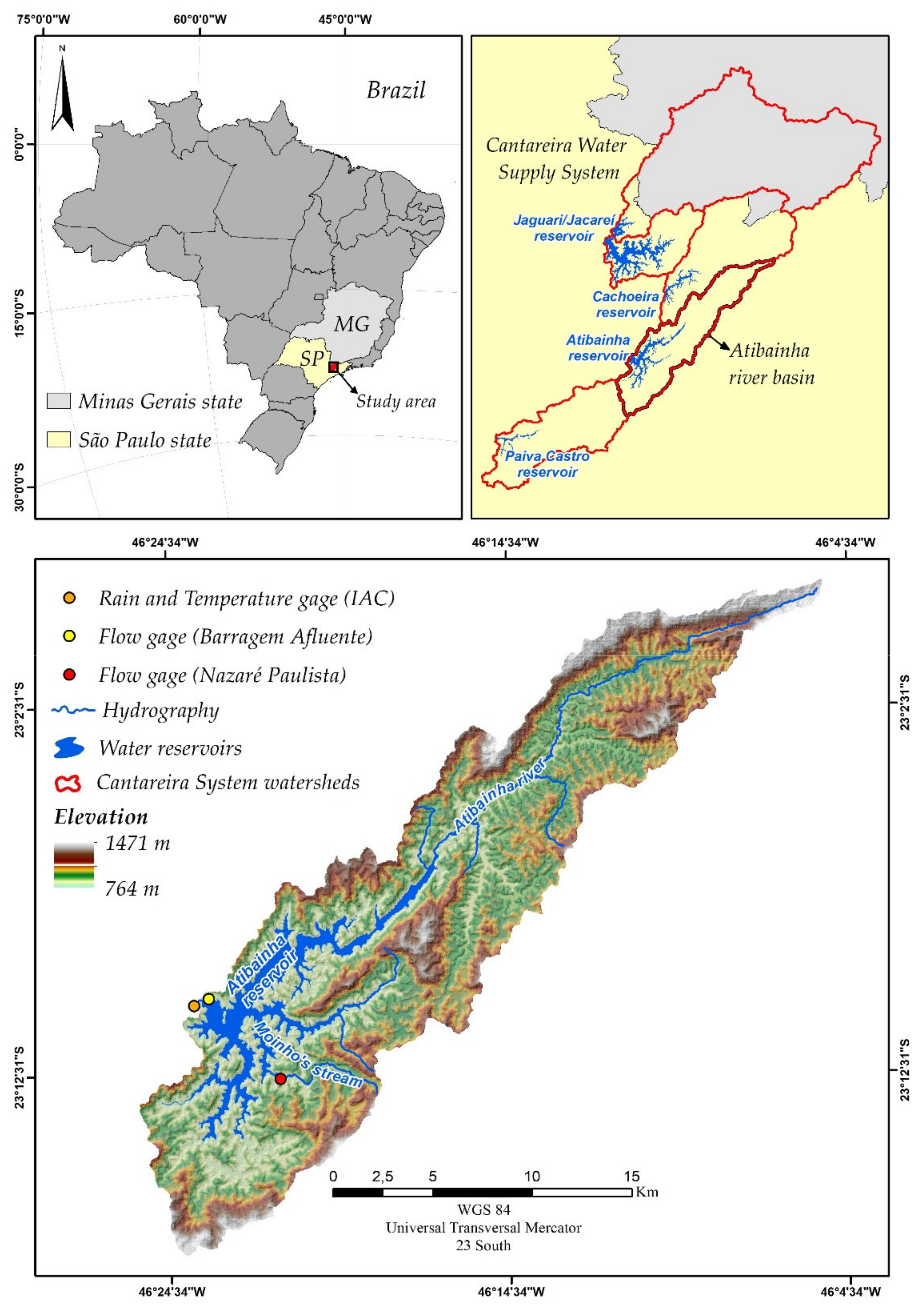
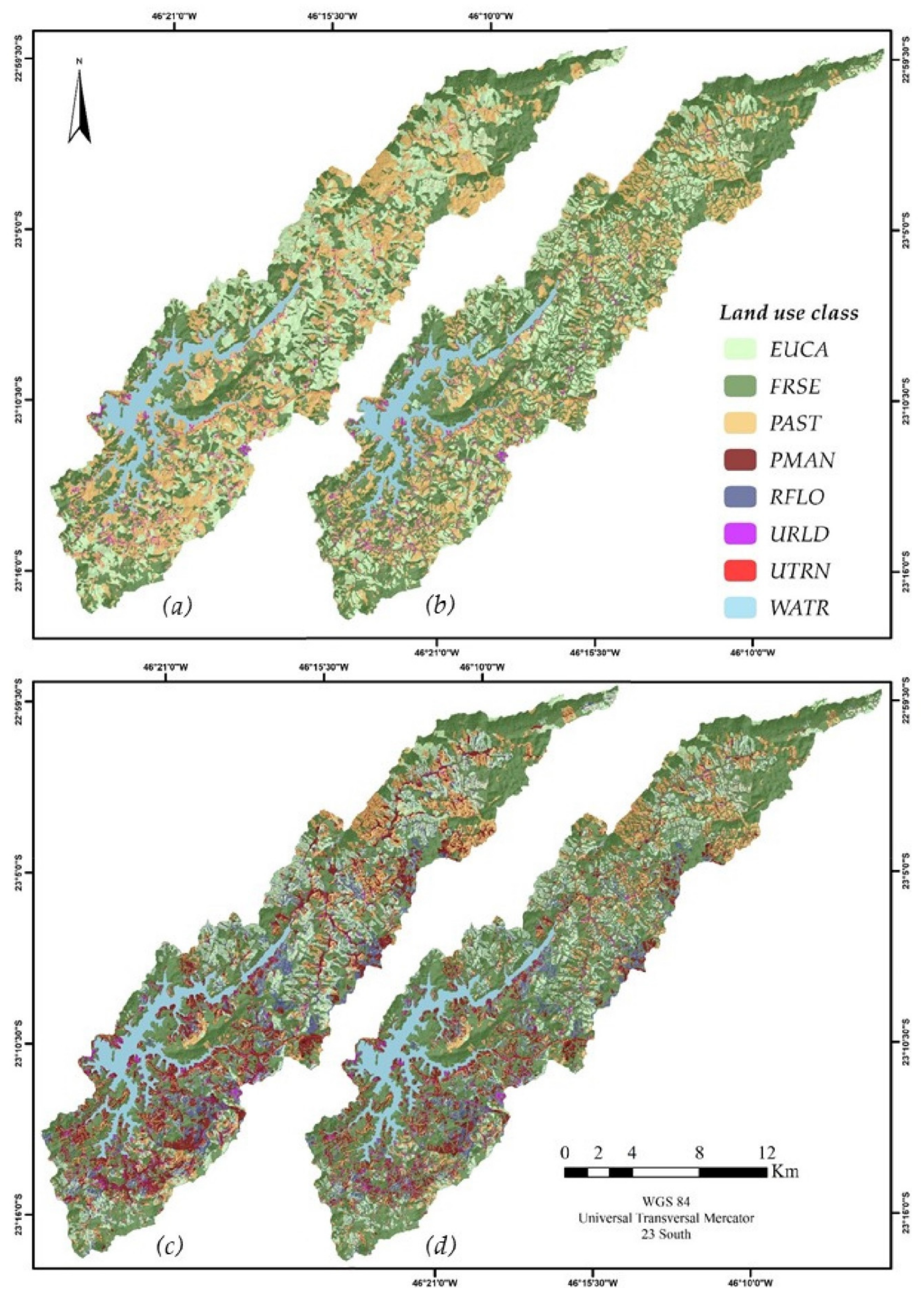
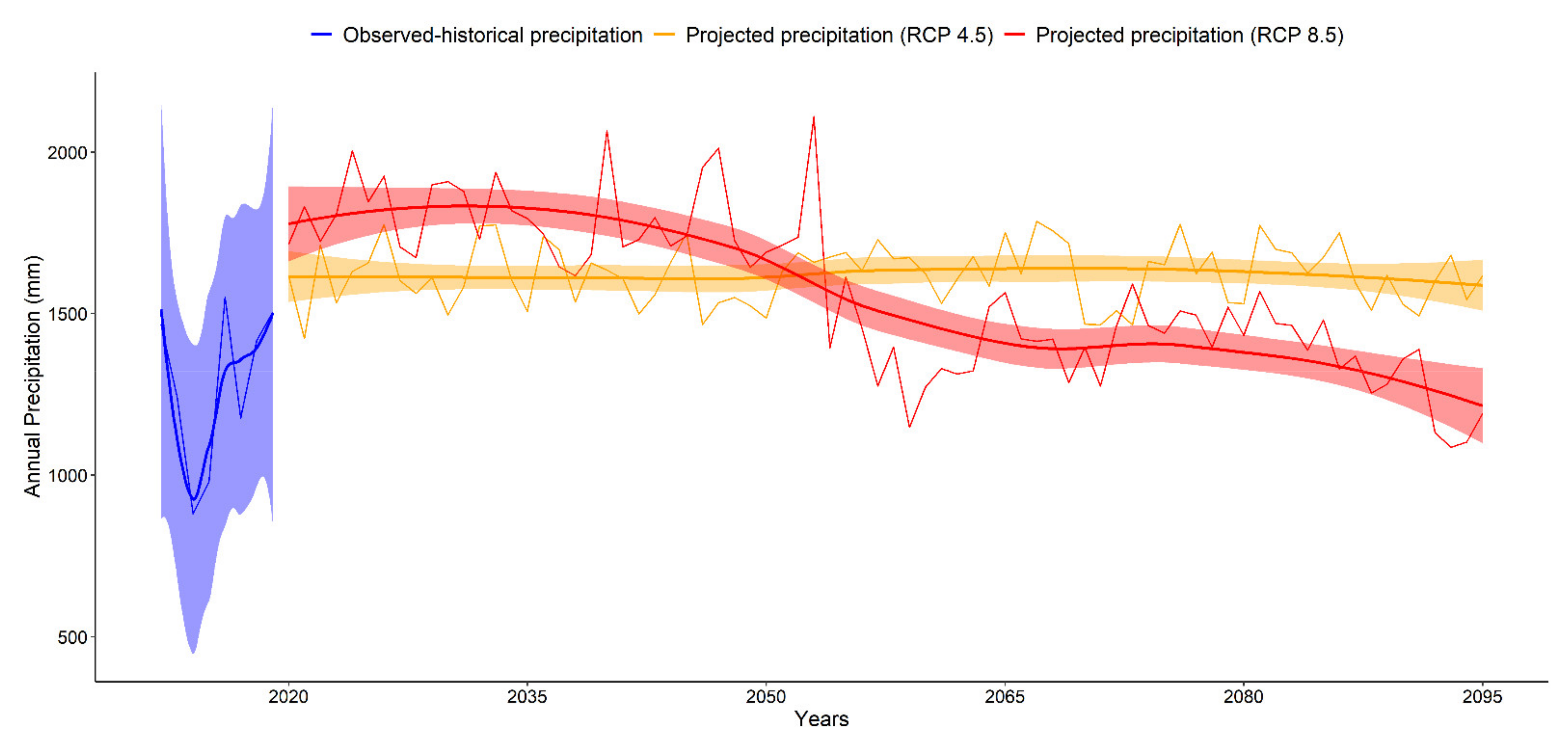
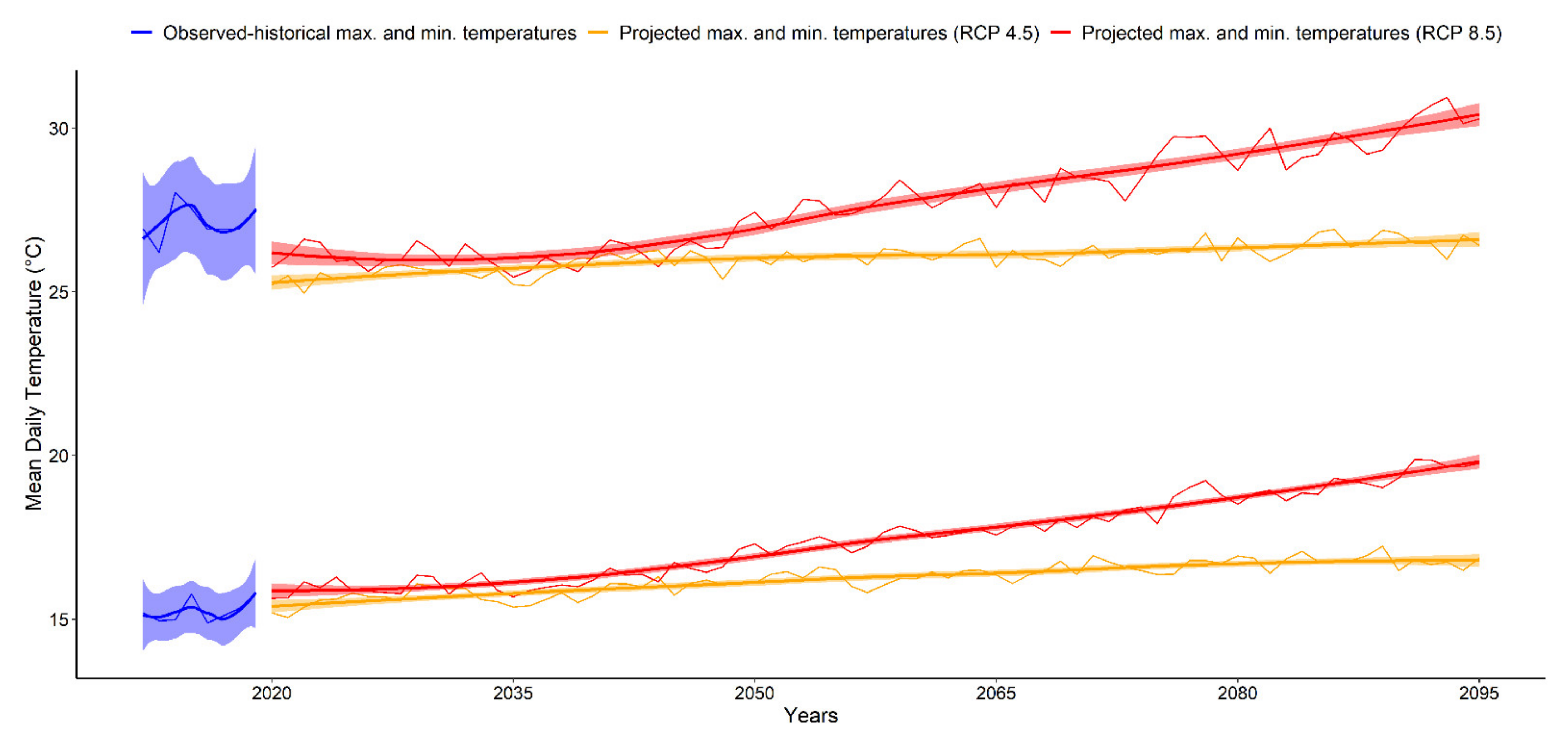
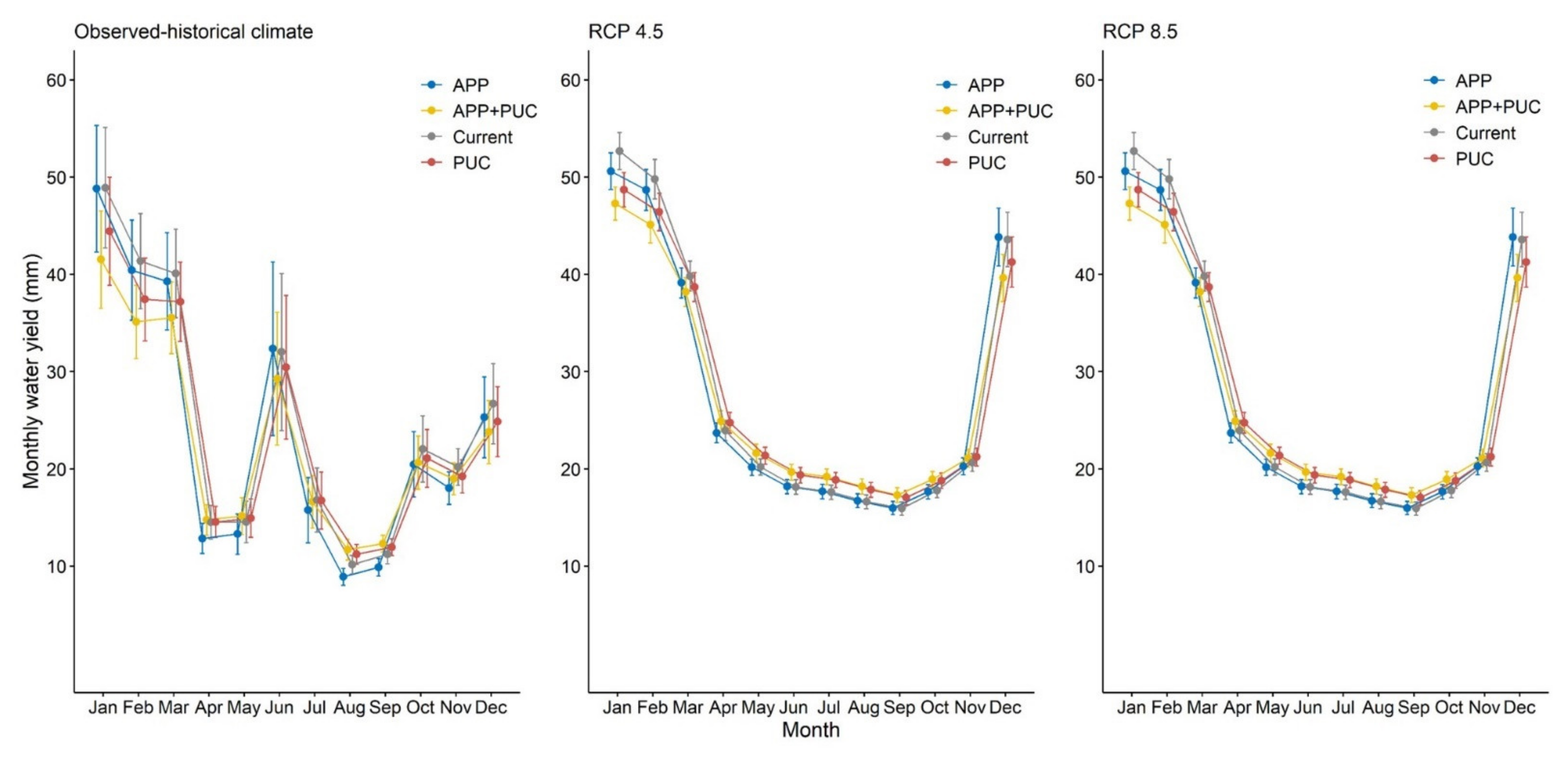



| Data | Description/Properties | Scale | Source |
|---|---|---|---|
| Topography | DEM from SRTM mission with radiometric and terrain correction, and the spatial scale altered from 30 to 12.5 m by the Alaska Satellite Facility | 12.5 × 12.5 m converted to 10 × 10 m * | Alaska Satellite Facility-Alos Palsar RTC products |
| Land use land cover map | OrbView, WorldView, and SPOT-5 satellites images (2011 and 2012) ** | 1 × 1 m converted to 10 × 10 m | [30] (modified) |
| Soils map | Soils map of São Paulo State, modified | 1:50,000 converted to 10 × 10 m | [31] (modified) |
| Rain and temperature gauges | Precipitation (mm) and the maximum and minimum air temperatures (°C) (2009–2019) | Daily mean | Agronomic Institute of Campinas (IAC) |
| Water Body Type | Water Body Width/Surface Area | APP Width |
|---|---|---|
| River | <10 m | 30 m |
| 10–50 m | 50 m | |
| 50–200 m | 100 m | |
| 200–600 m | 200 m | |
| >600 m | 500 m | |
| Lake * | <20 ha | 50 m |
| >20 ha | 100 m | |
| Spring ** | - | 50 m |
| Scenario | Land Use Land Cover Area (%) * | |||||||
|---|---|---|---|---|---|---|---|---|
| EUCA | FRSE | PAST | PMAN | RFLO | URLD | UTRN | WATR | |
| Current | 25.18 | 38.48 | 27.1 | - | - | 1.67 | 1.26 | 6.31 |
| Riparian restoration | 20.32 | 49.90 | 20.53 | - | - | 1.67 | 1.26 | 6.31 |
| Focal conservation | 15.16 | 38.48 | 11.57 | 15.52 | 10.02 | 1.67 | 1.26 | 6.31 |
| Combined solution | 12.75 | 49.90 | 9.81 | 10.72 | 7.57 | 1.67 | 1.26 | 6.31 |
| Maximum Temperature (°C) | Minimum Temperature (°C) | Precipitation (mm) | |
|---|---|---|---|
| Observed values | 27.1 | 15.3 | 1276.9 |
| Climate Change Projection | Estimated Temperatures (°C) | Percent Change (%) | |
| RCP 4.5 (P1) | 25.7 | 15.8 | 26.1 |
| RCP 4.5 (P2) | 26.3 | 16.6 | 27.7 |
| RCP 4.5 (Annual) | 26.0 | 16.2 | 27.0 |
| RCP 8.5 (P1) | 26.3 | 16.3 | 41.0 |
| RCP 8.5 (P2) | 28.8 | 18.4 | 8.1 |
| RCP 8.5 (Annual) | 27.7 | 17.5 | 22.8 |
| Streamflow (m3/s) | Water Yield (mm) | Surface Runoff (mm) | Lateral Flow (mm) | Groundwater Flow (mm) | Sediment (t) | |||||||||||||
|---|---|---|---|---|---|---|---|---|---|---|---|---|---|---|---|---|---|---|
| Simulated values for the base model | 3.0 | 298.5 | 128.4 | 80.2 | 8.1 | 2646.9 | ||||||||||||
| Percent Change (%) | ||||||||||||||||||
| Observed historical climate | ||||||||||||||||||
| APP | −4.0 | −4.4 | 3.5 | −6.0 | −14.6 | −9.9 | ||||||||||||
| PUC | −4.2 | −4.7 | −22.3 | 0.5 | 16.8 | −10.8 | ||||||||||||
| APP + PUC | −6.9 | −7.8 | −34.3 | 0.9 | 24.4 | −22.5 | ||||||||||||
| RCP 4.5 | P1 | P2 | Annual | P1 | P2 | Annual | P1 | P2 | Annual | P1 | P2 | Annual | P1 | P2 | Annual | P1 | P2 | Annual |
| Current | 12.4 | 18.3 | 15.7 | 13.5 | 19.5 | 16.8 | −61.7 | −58.3 | −59.8 | 11.6 | 15.9 | 14.0 | 121.0 | 131.9 | 127.0 | −82.1 | −73.2 | −77.2 |
| APP | 11.1 | 17.0 | 14.4 | 12.1 | 18.0 | 15.4 | −66.7 | −63.3 | −64.8 | 9.4 | 13.5 | 11.7 | 125.7 | 136.6 | 131.7 | −84.1 | −75.9 | −79.6 |
| PUC | 11.4 | 17.2 | 14.6 | 12.4 | 18.3 | 15.6 | −73.9 | −71.3 | −72.5 | 11.7 | 16.1 | 14.1 | 135.6 | 147.6 | 142.2 | −83.4 | −74.8 | −78.7 |
| APP + PUC | 10.4 | 16.2 | 13.6 | 11.2 | 17.2 | 14.5 | −77.2 | −75.1 | −76.0 | 10.2 | 14.7 | 12.7 | 138.1 | 150.8 | 145.1 | −85.2 | −77.3 | −80.9 |
| RCP 8.5 | P1 | P2 | Annual | P1 | P2 | Annual | P1 | P2 | Annual | P1 | P2 | Annual | P1 | P2 | Annual | P1 | P2 | Annual |
| Current | 73.5 | −38.2 | 11.8 | 76.3 | −38.6 | 12.8 | −18.3 | −76.3 | −50.4 | 51.2 | −30.4 | 6.1 | 228.1 | 8.4 | 106.7 | −58.4 | −84.3 | −72.7 |
| APP | 72.4 | −39.6 | 10.5 | 75.0 | −40.1 | 11.4 | −19.3 | −79.2 | −52.4 | 47.0 | −32.8 | 2.9 | 229.5 | 10.0 | 108.2 | −62.4 | −86.0 | −75.4 |
| PUC | 72.5 | −38.7 | 11.0 | 75.2 | −39.2 | 12.0 | −38.8 | −83.1 | −63.3 | 52.3 | −30.8 | 6.4 | 254.8 | 17.1 | 123.5 | −61.8 | −85.3 | −74.7 |
| APP + PUC | 71.5 | −39.6 | 10.1 | 74.0 | −40.2 | 10.9 | −47.3 | −85.1 | −68.2 | 52.2 | −32.7 | 5.3 | 263.6 | 18.4 | 128.1 | −66.3 | −86.7 | −77.6 |
| Climate Scenario | LULC Scenario | Water Yield (SE) | Streamflow (SE) | ||
|---|---|---|---|---|---|
| Annual Mean | Monthly Mean | Annual Mean | Monthly Mean | ||
| Observed historical climate | Current | 116.3 | 22.1 | 1.034 | 3.050 |
| APP | 116.6 | 23.2 | 1.066 | 2.930 | |
| PUC | 108.1 | 19.6 | 0.950 | 2.918 | |
| APP + PUC | 102.4 | 17.8 | 0.902 | 2.838 | |
| RCP 4.5 | Current | 61.9 | 14.7 | 0.504 | 3.605 |
| APP | 61.9 | 14.0 | 0.503 | 3.565 | |
| PUC | 61.6 | 12.8 | 0.495 | 3.571 | |
| APP + PUC | 61.5 | 12.3 | 0.493 | 3.540 | |
| RCP 8.5 | Current | 187.3 | 23.7 | 1.815 | 1.888 |
| APP | 188.0 | 23.9 | 1.824 | 1.846 | |
| PUC | 186.3 | 22.0 | 1.807 | 1.870 | |
| APP + PUC | 185.9 | 21.3 | 1.804 | 1.842 | |
| Parameter | Climate Condition | Statistically Different Scenarios (p-Value) | |||
|---|---|---|---|---|---|
| Current | APP | PUC | |||
| Groundwater flow | RCP 4.5 | PUC | 0.017 | - * | NA ** |
| APP + PUC | 0.001 | 0.028 | - | ||
| Surface runoff | RCP 4.5 | APP | 0.006 | NA | |
| PUC | 0.001 | 0.001 | NA | ||
| APP + PUC | 0.001 | 0.001 | 0.002 | ||
| Surface runoff | RCP 8.5 | PUC | 0.028 | - | NA |
| APP + PUC | 0.003 | - | - | ||
| Sediment loads | RCP 4.5 | APP + PUC | 0.003 | - | - |
Publisher’s Note: MDPI stays neutral with regard to jurisdictional claims in published maps and institutional affiliations. |
© 2022 by the authors. Licensee MDPI, Basel, Switzerland. This article is an open access article distributed under the terms and conditions of the Creative Commons Attribution (CC BY) license (https://creativecommons.org/licenses/by/4.0/).
Share and Cite
de Freitas, L.D.; de Moraes, J.F.L.; da Costa, A.M.; Martins, L.L.; Silva, B.M.; Avanzi, J.C.; Uezu, A. How Far Can Nature-Based Solutions Increase Water Supply Resilience to Climate Change in One of the Most Important Brazilian Watersheds? Earth 2022, 3, 748-767. https://doi.org/10.3390/earth3030042
de Freitas LD, de Moraes JFL, da Costa AM, Martins LL, Silva BM, Avanzi JC, Uezu A. How Far Can Nature-Based Solutions Increase Water Supply Resilience to Climate Change in One of the Most Important Brazilian Watersheds? Earth. 2022; 3(3):748-767. https://doi.org/10.3390/earth3030042
Chicago/Turabian Stylede Freitas, Letícia Duarte, Jener Fernando Leite de Moraes, Adriana Monteiro da Costa, Letícia Lopes Martins, Bruno Montoani Silva, Junior Cesar Avanzi, and Alexandre Uezu. 2022. "How Far Can Nature-Based Solutions Increase Water Supply Resilience to Climate Change in One of the Most Important Brazilian Watersheds?" Earth 3, no. 3: 748-767. https://doi.org/10.3390/earth3030042
APA Stylede Freitas, L. D., de Moraes, J. F. L., da Costa, A. M., Martins, L. L., Silva, B. M., Avanzi, J. C., & Uezu, A. (2022). How Far Can Nature-Based Solutions Increase Water Supply Resilience to Climate Change in One of the Most Important Brazilian Watersheds? Earth, 3(3), 748-767. https://doi.org/10.3390/earth3030042







